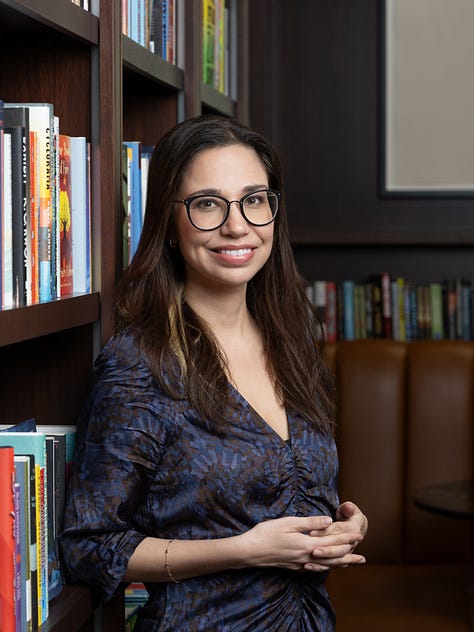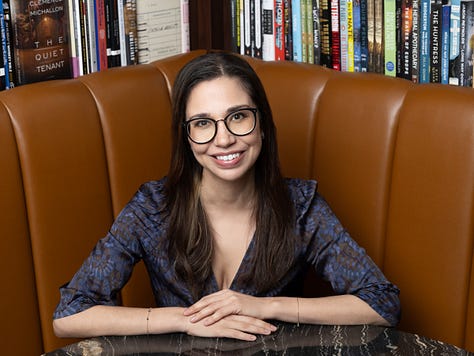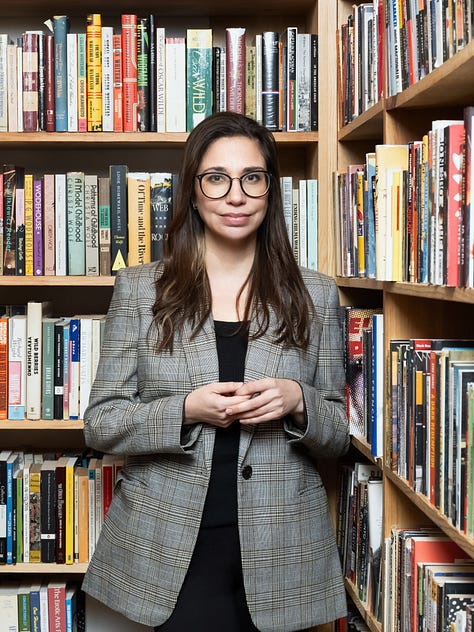Hey, This is Me: An Interview with Author Photographer Beowulf Sheehan
"I encourage the thinking that you've already been so bold on the page, so let's be bold just a few more times in photographs."
When I was itemizing my business expenses this year, my accountant raised his eyebrows at the deduction of a hair and makeup artist fee for my author photo. Ron, a man with opinions, was shocked that I would hire someone to do my hair and makeup for “just one photo!”
I regret nothing, especially not hiring Beowulf Sheehan to take my author picture, an experience which entailed running allover lower Manhattan on one of the coldest days of the year and posing in front of a Soho storefront in a cowl that made me look like a druid. (If you preorder my book, I’ll send you the Gandalf outtakes.) Beowulf is widely known as one of the best and most creative "literary portrait creators” in the world. He is also the author of AUTHOR: THE PORTRAITS OF BEOWULF SHEEHAN, a collection of his photos, which includes beautiful portraits of Donna Tartt, Toni Morrison, Salman Rushdie, Zadie Smith and Karl Ove Knausgard, among others. (We didn’t know each other yet at the time of publication, hence my exclusion.)
Beowulf knows a lot about writers and publishing, so much so that after talking to him, I had a real-life Stop the Presses moment and added some very last minute information to the book, gleaned from the interview you’re about to read. Beowulf has a ton to say about author portraiture but he is also so astute about the psyches of authors. Read on if you’re interested in:
Why an author photo is so important and what makes for a great one
How to communicate with your photographer to achieve a photo you love—and what to do if you don’t love your photographer’s results
How to think about your book’s visual language as part of how you communicate with your reader
Beowulf’s considerable all-around wisdom
I loved interviewing Beowulf. He’s truly best-in-class at what he does, and he’s so good at paying attention to details while never losing sight of why creative people do what you (we?) do; his last answer in this interview made me tear up a bit. As for our work together, you can take a look at the photos here and let me know if you agree with Ron. Also, there was a completely unexpected but very clear gender divide when I polled friends on their favorites! Guesses welcome, and let me know your favorite too.



Before we get into what makes a great author photo, let’s start with the timeline for taking one. When should an author get their author photographs taken? And why is it so long before their book comes out?
It is long before the book comes out. Depending on the publisher, it is anywhere between three months, which is really quick, and twelve to fifteen months before publication. It's done so far out because the photograph isn't needed only for the book itself and promotions to the public. There are also promotions behind the scenes, before the public is ever engaged. It’s important for the author's portrait to be in the publisher’s catalog, to be a part of internal presentations, and to accompany advanced reader copies. It's also important because the people who are considered critical influencers can get a sense of who the author is from that picture.
Having the author portrait on the galley is critical because you're building momentum for the book. It's not the end of the world if the author portrait isn't on it, but why would you say no to a further opportunity to promote your work?
There are also the mechanics of getting the photo right. How do they work?
Once I've had the author portrait session, I make what's called a review page. This online page features all the content that's gotten past my eye that I think is worth considering for either the author portrait or for an editorial/publicity image beyond the author portrait. Once the winning picture is chosen by the writer, my retoucher needs a business week to turn it around. And, just as an essay or a manuscript has multiple passes, that author portrait is likely going to have multiple passes, because retouching is a language being spoken by the author, my retoucher, and me. I want the portrait to look the way the author wants to be seen. This takes time. Having a few weeks’ lead time ahead of a publisher’s deadline means we have no pressure to meet it.
We don't necessarily intuit the mechanics of a professional, beautiful photo that will go on a jacket and exist forever. It’s analogous to what it takes to publish a finished book. There are a lot of hands involved, and it's time consuming. In every step of this process, you want to give yourself as much time as possible to get it right and to give grace and time to the artist that helped you make this thing in the world, be it your editor or your photographer, your retoucher or your copy editor, because it's real people working with real things.
We live with this near daily cliche in our vernacular of "overnight success" when absolutely nothing worthwhile happens overnight. When it comes to something as landmark as a book, it's never an overnight thing. We were speaking earlier about the need to have the author portrait on the ARC. That has me thinking further about the vitality of that content. That's just it. There's so much competition out there. There's so much content out there.
You have two visual languages, two words of visual language being spoken to the reader, to the viewer with each book. One communication is the cover. The other communication is the author portrait. To not have two options, but just one in the cover, would be such a shame. I believe we largely speak visual language before we speak verbal language. To engage the viewer with what we see on two visual counts is so vital. So, too, I think, is having both compelling cover content and an author portrait image to get the viewer to think, “Wow, who is this? I'm going to grab this book and read a little bit more. Okay, I think I'll buy this.” When this happens, we, as author portrait photographer and as cover designer, have done our jobs to get the viewer to be so stoked as to grab the book, buy it, and become the reader. That's my job, to help turn the viewer into the reader.
We're going to get a little meta so authors who may not have access to working with you can glean something from your approach. When we did our photo shoot together, you had this very detailed plan to take me to multiple locations across Manhattan. Perhaps not every author photographer can give such a Rolls Royce treatment, but if you're an author going into this experience and thinking about your photos, how can you bring some intentionality to the location or the mood or the theme of the photos?
I was able to glean how to see you by way of two great things: one, having the chance to read your work, and then having the chance to speak with you and for you to openly tell me what it is you're after. For anyone being photographed by another photographer, it is invaluable for the writer to say, "Hey, this is what I'm dreaming of." There's nothing wrong with shooting for the stars. Just put it out there. "I dream of being photographed this way." "I've always loved this portrait of Person X, can you photograph me that way?" "I love this location. I want to be photographed there." There's nothing wrong with being told no. Being a writer, being an artist in any medium, means getting used to being told no. With every no, you get stronger, and it places all the more value on when you’re told yes.
You might not have a photographer who asks how you want to be seen, or where you want to be shot, or what mood you want to convey, but you can be proactive about telling them.
Absolutely.
I put together a mood board for both my book jacket and for you, and it was your idea to put together some inspiration. I would advise authors to do that.
I encourage the thinking that you've already been so bold on the page, so let's be bold just a few more times in photographs. Tell the photographer what you want. Tell the cover designer what you want. This is what you dream of, too.
Could you share some other locations that you've used in past photos that you felt like really worked?
I have photographed writers in the rain, in the snow. I have photographed writers in the street. I photographed a writer under a waterfall.
As I said earlier, I believe we live in a world in which the visual is spoken first, and the chatter is non-stop. Even if we want to take a break, something is being said to us in the visual, whether we want to have a conversation at that time or not, and if we open up our phones, the chatter is off the charts, which means that we're exposed to who knows how many hundreds of thousands if not millions of images in any single year. How do we come across a picture that makes us stop?
I also recognize that we're human beings. We have our similar constructs, and yet each of us is individual and beautiful, just as we all are. An author portrait usually has certain qualities to it, usually somewhere from about chest up, with a face engaged or disengaged from the reader in certain ways, but there's negative space beyond that framing, and perhaps we can pull back a little bit and have something different to offer.
The need for harmony works, and the occasional disharmony works, too. Anything we can do to get the viewer to stop and say, "Oh my goodness, wait, what did I just see? Go back to it, that person's so striking. What is this person's book all about?" As soon as that happens, I've more than done my job, because then I've hopefully helped to enthrall that viewer and to convince them to take in the person's work and buy the book. Even if you've seen photographs like yours a thousand times over, your photograph is still your unique photograph. That picture doesn't exist anywhere else in human history. It's you. If we can do something along the way that's a little different with that photograph, terrific.
When an author gets their review page back with their photos, how might they think about narrowing it down to one or two?
I'm thinking of what happens when you try to find a home. When you move to a new city, it's time to get an apartment. You go apartment hunting, and you walk through this door and that door and this door and that door, and at some point you walk through a door, and as you enter that room, you feel like you're at home. Oh, this is me. This is home.
That's how you should feel when you see that picture: Oh, this one is talking back to me. Just let yourself be open. I think if you put constraints on yourself as you look through the review page and as you're being photographed, you limit the ability for the reader to feel you. You have to open yourself up to the reader. The photo being taken for your author portrait is not a conversation with a photographer and the subject. It is a conversation between the subject—the writer, the author—and the reader. The photographer is the conduit of that conversation.
My reaction to our session was: I love everything. But let's say you are an author who engages a photographer, and when you get back your photos, you don't love them—and you know ego is involved. What might the author say to the photographer to get where they want to get with the photos?
I think it's a matter of being open. To tell another person what's going on in your head and heart is a hard thing to do. The nature of a book is, in some way, the writer saying, “Hey, this is me, and I'm so excited to tell you about this part of me.” An author portrait is doing the same thing, and it's never complete. It's never a whole image, in that we as human beings cover the spectrum of everything that we feel and do at different points in our lives. I'm sure there's fear in saying that to the photographer, “Look, this is actually what I wanted instead.” There is a word in creative industries called pickup, which means we missed something, so we're going to have to have a pickup day.
You have this really lovely thing you say when you're photographing to always remind the subject, the author, to think of their reader and to think of you as the reader. I found that very helpful to think about as I was being photographed. Being photographed, if you're not used to it, is awkward. But thinking about your reader is very intuitive for someone who has spent a year, two years, three years, writing a book. That's who you've been thinking about for years, so actually reminding yourself of the larger purpose and the target is quite centering.
I think a book tour is a gratitude tour. You meet all these strangers who come out for your story and for you, and there are booksellers there who are preparing your work and preparing a space for you to sit and talk to people you largely don't know. Literature is not necessarily something that's engaged with for a life of lucrative income. It's a labor of love. That gratitude tour should be a beautiful, rewarding experience. The first chance you have to say, “Thank you!” is in that author portrait. You’ll soon have to get used to saying thank you and smiling a lot. You don't have to necessarily smile in your author portrait. You can communicate whatever sentiment or emotion you wish to communicate to the reader, but to engage that reader early in saying thank you is great practice for the tour to come.
That's so lovely. Any closing thoughts?
I grew up as a reader because I didn't have the ability to play sports. I had asthma as a child, so I read a lot and found friends in books instead of finding them on the field of play. How beautiful it is to recall that happy childhood every time I make an author portrait! To create with a storyteller is such a great thing. I read comic books as a kid, and when the comic book would end, I didn't want to wait a whole month to go to 7-Eleven and get the next issue - so I would draw the superheroes a little bit and keep the story going myself. All these years later, I get to read books and draw superheroes with my camera. The superhero or superheroine is the author. What beautiful, heroic things you storytellers are doing out there. Thank you for a life and career of being able to support your work. It's been and still is joyous.




Yes! The photographer as reader! I will not forget that. Your photos are fabulous.
Thank you for this excellent, informative post and your photos look GORgeous, I especially like #2!